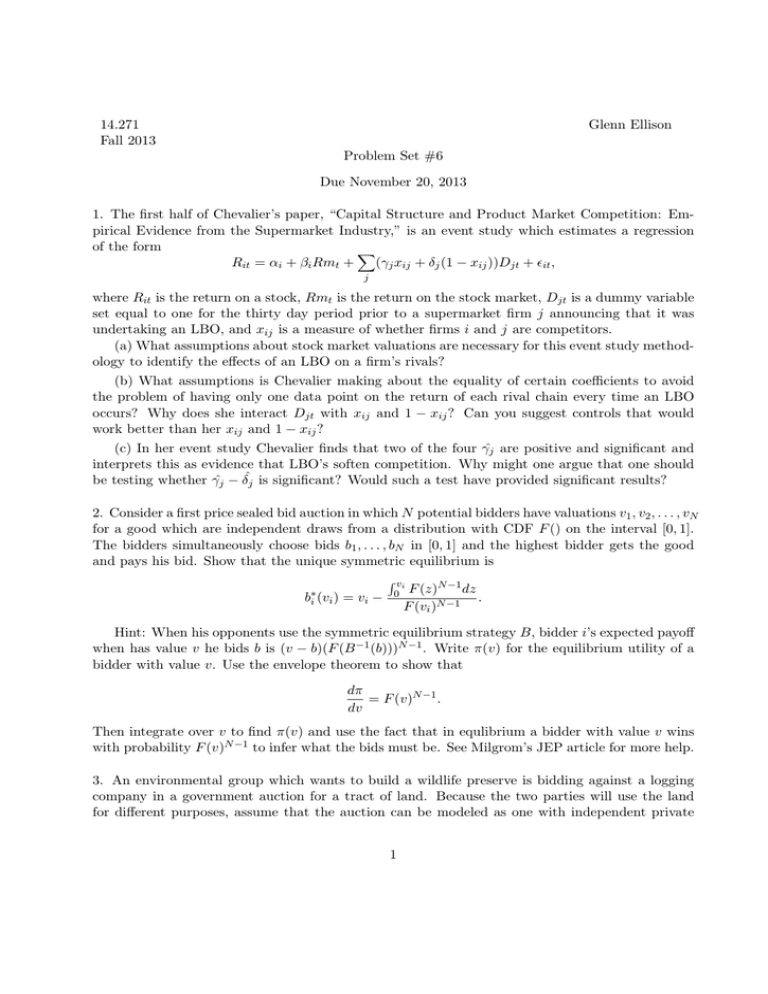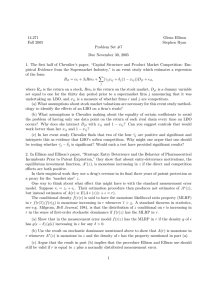Document 13433983
advertisement

14.271 Fall 2013 Glenn Ellison Problem Set #6 Due November 20, 2013 1. The first half of Chevalier’s paper, “Capital Structure and Product Market Competition: Em­ pirical Evidence from the Supermarket Industry,” is an event study which estimates a regression of the form Rit = αi + βi Rmt + (γj xij + δj (1 − xij ))Djt + Eit , j where Rit is the return on a stock, Rmt is the return on the stock market, Djt is a dummy variable set equal to one for the thirty day period prior to a supermarket firm j announcing that it was undertaking an LBO, and xij is a measure of whether firms i and j are competitors. (a) What assumptions about stock market valuations are necessary for this event study method­ ology to identify the effects of an LBO on a firm’s rivals? (b) What assumptions is Chevalier making about the equality of certain coefficients to avoid the problem of having only one data point on the return of each rival chain every time an LBO occurs? Why does she interact Djt with xij and 1 − xij ? Can you suggest controls that would work better than her xij and 1 − xij ? (c) In her event study Chevalier finds that two of the four γˆj are positive and significant and interprets this as evidence that LBO’s soften competition. Why might one argue that one should be testing whether γˆj − δˆj is significant? Would such a test have provided significant results? 2. Consider a first price sealed bid auction in which N potential bidders have valuations v1 , v2 , . . . , vN for a good which are independent draws from a distribution with CDF F () on the interval [0, 1]. The bidders simultaneously choose bids b1 , . . . , bN in [0, 1] and the highest bidder gets the good and pays his bid. Show that the unique symmetric equilibrium is b∗i (vi ) � vi = vi − 0 F (z)N −1 dz . F (vi )N −1 Hint: When his opponents use the symmetric equilibrium strategy B, bidder i’s expected payoff when has value v he bids b is (v − b)(F (B −1 (b)))N −1 . Write π(v) for the equilibrium utility of a bidder with value v. Use the envelope theorem to show that dπ = F (v)N −1 . dv Then integrate over v to find π(v) and use the fact that in equlibrium a bidder with value v wins with probability F (v)N −1 to infer what the bids must be. See Milgrom’s JEP article for more help. 3. An environmental group which wants to build a wildlife preserve is bidding against a logging company in a government auction for a tract of land. Because the two parties will use the land for different purposes, assume that the auction can be modeled as one with independent private 1 values. Assume that it is common knowledge that the environmental group’s valuation for the land, ve , is drawn from a uniform distribution on [0, 2], and that the logging company’s valuation, vc is drawn from a uniform distribution on [1, 2]. (a) Find the equilibrium strategies and the probability with which each party wins the tract in a second price sealed bid auction. What is the government’s expected revenue? Would you expect a first price sealed bid auction to raise more, less, or the same amount of revenue (in expectation)? (b) In what ways is the asymmetric auction model described above very different from that used by Hendricks and Porter to model the asymmetries between firms in bidding for offshore oil drainage tracts? (c) Suppose that the seller also has a second unit to sell. It is common knowledge that player 2 would get no incremental benefit from winning a second unit. Player 1 would get the same benefit from the second unit that he gets from the first (what this is remains private information and uniformly distributed on [0, 2].) Consider a multiunit ascending auction in which the two bidders are asked to raise two hands if they want 2 units at p and one hand if they want one unit at p, with bidding ending as soon as only two hands are raised. Find a perfect Bayesian equilibrium of this game. What is the seller’s expected revenue? What is the probability that the goods are allocated efficiently? 4. In a two player model where the player’s valuations are independent uniform on [0, 1], find the equilibrium of a variant of a first price sealed bid auction in which the seller announces a reserve price of R and sells the good to the highest bidder only if the winning bid is at least R. 2 MIT OpenCourseWare http://ocw.mit.edu 14.271 Industrial Organization I Fall 2013 For information about citing these materials or our Terms of Use, visit: http://ocw.mit.edu/terms.




